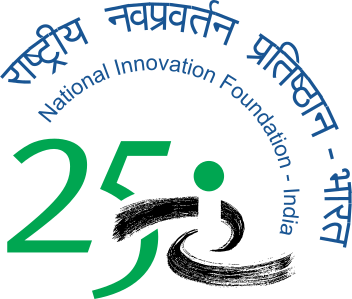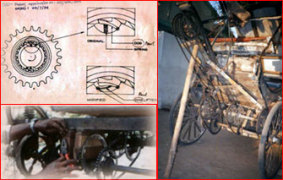Personal profile
Sheikh Jabbar grew up in a traditional weaver’s family in a village near Nagpur. But in the late 50s and 60s mechanization led to the closure of these mills and the family’s only source of livelihood came to an end. So they started looking for alternatives and Jabbarbhai took to auto driving and later turned to truck driving. Currently he ferries school children from school and back on his cycle-rickshaw to earn his living and operates within a radius of 2km from his house. He also has a small rickshaw repairing shop to supplement his earnings. Jabbarbhai has married thrice and now lives with his third wife and three children, two sons and a daughter. His children are studying in a local school and his wife Shakeela works as a maid and earns about Rs.1000/- a month. Jabbarbhai has four children from his earlier marriages. But he regrets the fact his sons are not interested in his work. But inspite of all the hardships and the ups and downs of life he has lived through, at 70, there is a sense of serenity and calmness on Jabbarbhai’s face, a rare sight in today’s world.
“This innovation will make it easier for rickshaw pullers as it helps to prevent fatigue and the common health problems which rickshaw pullers are prone to.”
Thats what Jabbar Sheikh declares, the grassroot innovator designed a variable gear system for cycle rickshaws inspite of financial constraints and ridicule at his attempts of ‘becoming an engineer.’
Genesis
Once Jabbarbhai was watching a rickshaw puller driving in front of his truck and it struck him that he could make the rickshaw puller’s life easier by attaching another gear to it. He went on thinking about it and one day the whole picture of how such a system could be made was ready in his mind. Quite excited he discussed this idea with his friends but got nothing but ridicule for it. Their response made him also feel slightly sceptical as he thought that if anything could be done on a rickshaw, others would have already done it especially as “there are many highly qualified people in the world who would have thought about it”. The only thing which kept nagging him was the fact that rickshaws are designed by people who do not use them and therefore are not familiar with the problems the rickshaw pullers face. This motivated him to pursue his idea and he went to a fabricator and discussed it, but the fabricator also discouraged him and even said that the idea was impractical and could never be realised.
Determined not to give up his idea, Jabbarbhai left off driving trucks and bought a rickshaw for Rs.550 in 1975 with the dual purpose of earning his living as well as trying out his ideas on it. Though the idea of fitting a gear often crossed his mind, he found that he had neither the time nor the resources to work on it. The daily rigour of pulling rickshaws also took its toll on his health and he fell sick and could barely work for more than 2-3 hours which lead to a constant decline in his earnings. Finally one day he felt that it was high time to work on the as he needed to earn more, particalarly as his daughters needed to be married off and he himself was getting older too. With this aim he bought some tools and spare parts and began developing his “two-gear rickshaw”. In his free time he would open the freewheel, axle and other parts of the vehicle to understand its mechanism. Completely involved he would lose all sense of time and wake up at odd hours. He used to go around hunting for scrap and spare parts in the Chor Bazaar and would go without food for hours. Soon his wife also began assisting in the gear system. His friends and relatives ridiculed his lofty ideas and asked him why he tinkered with a well functioning and new rickshaw, but none of this deterred him from the pursuit of his goal.
Fifteen years after the idea struck him the two-gear rickshaw was ready - after umpteen highs and lows - and he could ride it for the first time in 1989. Jabbarbhai continued to improve his innovation. Next he developed a four-gear differential system with double axle, which would overcome a mechanical flaw extent in the normal rickshaw where only one of the wheels is powered from the torque given by the puller. Whereas here by transferring it to both wheels, it became a “two-wheel” drive. The next stage in development was a four-gear rickshaw with differential mechanism and single axle in which the double-axle was removed and a single continuous axle was introduced. The power from the paddle was thus transferred to both the wheels, but in a much simpler fashion and it also reduced the add-on weight.
The principle employed in the gear-system developed by Jabbarbhai is similar to the double sprocket system, where two free wheels are used. Free wheel is a simple but indigenous mechanism which allows rotation in one direction and becomes free in the reverse direction. Jabbarbhai used this mechanism and converted it into a gear system. He devised a mechanism in which the gear is changed or engaged with the help of a dog-lift, which can be activated by the rickshaw-puller with the help of the lever attached to the handle. As soon as the puller pulls the string, the dog-lifter is released and the cam gets released- it moves up and in turn gets locked with the teeth inside the free wheel and thus the gear is engaged. Once the vehicle gains some motion, the puller shifts to second gear.
Thus the modified system has the following features -improved free wheel, multi-gear system, drum brake means and multi-chain system. It is simpler in construction, of lower cost and easier to maintain compared to similar devices which have got US patents. Compared to the traditional rickshaw cycles and the ones developed by IDC and IIT Delhi, this model developed by Jabbarbhai has three and four gear speed options.
Disc brake at the back
Apart from this gear system Jabbarbhai has also made a few other modifications to improve the performance of his rickshaw. One is that of a disc-brake at the back which is adapted skilfully for a cycle rickshaw. Normal rickshaws have their brakes fitted on the front wheel; but this has some disadvantages as the rickshaw has a tendency to upturn if brakes are applied suddenly, especially when travelling fast as the puller might loose control of the vehicle. This would be an added risk for Jabbarbhai especially as his rickshaw has four gears, but with this brake system that problem would be solved. In a normal rickshaw simple metal-flats are used to absorb the bumps. Jabbarbhai added a spring along with a metal flat in a slightly different manner and this has improved shock qualities.
The struggles
Jabbarbhai relates how the whole experience of developing an idea into a tangible product was a long arduous process. How there were days and nights when he used to feel utterly depressed and lost because initially his idea would not work. And unfortunately he could not even discuss this with anyone as they anyway considered it foolishness or madness. Sometimes his colleagues would peep into his workshop and laugh at him or walk away without comprehension of his effort. Though at times he used to feel distressed and exhausted, what kept him working was the belief that this idea would indeed succeed. And when finally he successfully rode a double-geared rickshaw, his joy found no limits- “I was on top of the world.”
Unexpected support
Jabbarbhai’s experience with formal institutions such as research institutions, universities and the government left a lot to be desired as he found them rarely interested in doing anything tangible or substantial but just kept on giving false promises.
The exceptions were people from the alternative and appropriate science technology practices, who showed a lot of interest and got him funds where possible. Late Vinoo Kale, one of the key members of the Centre for Science for Villages (CSV), took a keen interest in this innovation and often used to travel in Jabbarbhai’s rickshaw as well as request his friends and relatives to travel on this rickshaw. Kale also approached the Department of Science and Technology, Govt of India, through CSV, for financial assistance for the development and promotion of Jabbarbhai’s innovation and got a sum of Rs. 95,000 sanctioned in 1992 for the pilot project of installing such gears on 24 cycles and this experience helped in getting necessary feedback and contributed to solve problems.
Kale also introduced Jabbarbhai to Prof.Yashpal, who covered this innovation in the popular programme on science, Turning Point on Doordarshan in 1992. On the 14th of April, 1997, Jabbarbhai left for Delhi on his rickshaw to attend a mela which Medha Patkar had invited him to inaugurate. He undertook the long journey via Bhopal, Mathura and Agra and would start driving his rickshaw at five in the mornings and go on till twelve midnight and then rest again and start in the morning. He finally reached Delhi after ten days and he remembers how on the way he met several well wishers who appreciated his innovation and offered him tea and food.
His current support in his innovations is Mr. Satish Ghanekar, a bank employee, who has a keen interest in mechanical problems coupled with a deep admiration for Jabbarbhai. Satish spends all his free time working with Jabbarbhai assisting him in various tasks.
Current status
Rickshaw-walas, in his neighbourhood were very excited but apprehensive as well about this innovation when Jabbarbhai originally came up with it. But now that they have seen him pulling it over years, they feel it works and they also want the system. But the system is expensive for them and they would require some financial help to implement it. Jabbarbhai at the same time laments that rickshaw pullers have looked down upon his innovation just because it has not come from a scientist or a laboratory. Otherwise he is sure that they would have appreciated it more. Jabbarbhai plans to own a few rickshaws so that he can install these gears on them give them to rickshaw pullers in order to promote its use. NIF has sanctioned him Rs.28,750 from the Micro Venture Innovation Fund for product development and demand estimation of this innovation. Jabbarbhai has filed for a patent.








